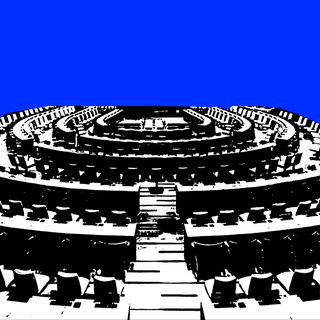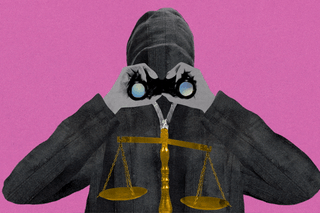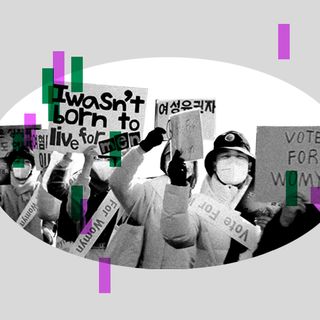
Stalking Is Romanticized as Passion. How Can Justice Systems Validate the Harm to Survivors?
Restorative justice is touted as the feminist answer to an unhelpful carceral justice system. For survivors of stalking — it can’t change what happened, but it can recognize that harm has taken place.

Last month, a woman from Chennai was killed by her stalker after she rebuffed his advances. Reports later showed that her family had tried in vain to register complaints against him, with the police instead trying to reconcile them.
Stalking is illegal under Section 354D of the Indian Penal Code. It’s meant to prevent any man from following, contacting, attempting to contact, or monitoring a woman who has clearly indicated disinterest. There’s one caveat, however: It’s not stalking if “in the particular circumstances such conduct was reasonable and justified.”
This is why some feminists are beginning to consider restorative justice. As a survivor-centric model of justice, the restorative process centers the survivor’s needs in order to address the harm that has taken place and, if possible, move survivors toward a place of healing. The framework, therefore, depends on the principle of repairing harm by addressing it rather than punishing it.
This sometimes involves something revolutionary: facilitating conversation between the harmed, and harm-doers. If it works, it could prevent future harm better than carceral justice systems can – because it fundamentally alters how people engage with one another. In the context of stalking, this would mean that stalkers begin to see the impact of their actions and reevaluate the context in which they’ve acted.
Within romantic relationships, stalking is almost invisible. It’s embedded into the very fabric of love in the country, where pop culture and the media have often depicted a man’s devotion and perseverance as the ultimate form of love. It’s why justice systems have failed victims and survivors of stalking.
What makes stalking a uniquely distressing crime is its complete and total invasion of a survivor’s space – physically, psychologically, emotionally. When we consider the criminal justice system’s capacity in that sense, the maximum punishment for stalking in India is 3 years of jail, 5 if it’s a repeated offense.
But even before it comes to sentencing, the institutional culture of disbelief when it comes to stalking forecloses the possibility of women being heard, or their experience being acknowledged as violence at all. Sohanee, 20, was reluctant to seek help when she was stalked by a person she’d known as a child. “I know they won’t move unless something ACTUALLY happens,” she says. This is telling: the “actually” in question refers to a physical attack, but the act of stalking itself is rarely considered with any finality. Restorative justice processes, however, allow the space for survivors to talk about how they’ve been harmed – and importantly, it validates stalking as violence.
Related on The Swaddle:
Let’s Start Treating Online Harassment As What It Really Is — A Crime
Moreover, the word “disappear” shows up a lot among survivors of stalking. It’s what they want for their perpetrators. But the current system is not nearly good enough to make the perpetrator “disappear” – and the violence of the prison system in India is in fact likely to make the risk of harm worse after the sentencing. If the perpetrator can’t disappear, can the risk?
According to restorative justice practitioners, it’s a possibility. The process has worked to bring peace to those who have experienced other forms of crime – including theft, assault, and even rape. Stalking is a little more complex, but there is still tremendous hope in the idea of applying restorative justice models to it due to how toxic socialized norms around love and entitlement can be unlearnt when the extent of harm is visibilized. It rests on the core principle of seeing the humanity in each other, and moving society forward to a place of non-carceral forms of justice. While some may argue that it places too much of an onus on survivors to see the humanity in violent men, many already do see it even without restorative justice processes.
Divya* was 18 when she began a relationship with a classmate. Over time and distance, things escalated in the form of abuse and surveillance from her boyfriend – eventually ending with him arriving at her campus after they’d broken up.
This is a common experience. The abuse included stalking – but not in the way that pop culture typically depicts it. He would harass her if she didn’t stay on the phone with him.
“[If] we are entering this conversation with the FACT that he abused me, I’d like an apology. I’d ask him to confess what he did to our mutual friends. Only because there’s a part of me that believes if he knew better and had more awareness growing up, he wouldn’t have done those things to me,” says Divya.
Divya maintains that although she wants the apology, she would not accept it. For her, the closure is in having him know, accept, and confess the pain and suffering he had caused her. “He thought he cared a lot about me. He devoted all his time to me. So he felt entitled to my whole life – and that was his idea of love.”
It’s not to say that survivors of stalking necessarily come to this understanding from empathy – sometimes, it’s a matter of being forced to for one’s own closure, especially when other forms of support are lacking. Nikita* experienced something similar. Her ex boyfriend went so far as to forcefully enter her house a few times and had her followed by others when he wasn’t in town. “He wasn’t held accountable by anyone but “glorified for his love for me. I was blamed and called a bitch by everyone for not forgiving and responding,” she says.
“I have had vivid thoughts of pushing him in front of a truck…” Still, provided she had the controlled, safe environment that restorative justice often entails, she says she would have liked to confront him. At times, being heard can feel like closure – especially when the culture is organized around not listening to women’s pain.
Arti Mohan, a practitioner of restorative justice, calls stalking a complex harm – in that the harm is often ongoing and there’s higher risks involved. “There has to be a lot of risk mitigation that needs to be done… Prep involves elaborate risk assessment – including the risk of being groomed or manipulated by the perpetrator [during the process],” she says of the process, but we can’t rule out the possibility of a permanent resolution to the issue. And further, it doesn’t always have to involve face to face conversations. There could be a surrogate, or a third party representative, who conveys things on either party’s behalf. “It depends on what the person harmed needs,” she says.
Related on The Swaddle:
Bollywood Needs Heroes Who Don’t Self‑Destruct When They’re in Love
It doesn’t always mean that restorative justice takes place outside the law either. “The need for safety is a very important and core need that any process would want to meet. Sometimes that involves sentencing, and it can go along with restorative justice. In an ideal world restorative justice leads to abolition and non-carceral outcomes. But unfortunately at times, it may need to complement the existing legal system – especially when there’s a safety concern,” explains Mohan.
The tension between criminal and restorative justice systems means that restorative justice systems across the world differ on the issue of stalking. In New South Wales, Australia, stalking is specifically excluded from the criteria for providing restorative justice. In the United Kingdom, it isn’t – and survivors have had their needs met through restorative justice processes.
For Divya and Nikita to understand why their abusers did what they did and be open to the conversation, the harm needed to have stopped. Nimisha Srivastava, who runs an organization that facilitates restorative justice processes, says that it’s possible for restorative justice to help survivors of stalking, but the recommendation for the process to take place has to be based on safety considerations first. “Sometimes restorative justice processes aren’t even desirable – where safety comes from the person not being in their life at all.”
Take the case of Lilin, who is 23 now, and was 19 when a stalker she didn’t know began harassing her online. He would upload her photos on porn sites, create fake accounts in her name, create groups consisting of people who left her hate comments, and eventually doxxed her. Lilin and her friends went to the police – but nothing happened. In the end, she put an end to it on her own by threatening legal action and finding out about the stalker’s college. “I just wanted them to be held behind bars for life because in my opinion, no amount of therapy or jail time can fix these men… I didn’t want to see blood, I just wanted them away from me.”
This is where restorative justice gets tricky when it comes to stalking.
“The first concern would be if the perpetrator is actually willing to understand and listen or just thinks of it as another opportunity to play victim and gaslight,” says Afza*, 33.
This is a real concern – as practitioners actively look for the risk of perpetrators manipulating the process to continue harm as part of their risk assessment.
Still, the wish for “disappearance” can take many forms once the harm has truly ended – even if it’s difficult to know when that is. As one of the recurring needs from a survivor’s point of view, it’s possible to come to a consensus where perpetrators never contact or enter the survivor’s life in any way again. “The outcome is possible, as long as what the survivor is asking for isn’t against the principles of restorative justice – like asking the perpetrator to stay confined to their house, for example,” says Srivastava.
There’s also a difference between restorative justice processes and restorative processes, Srivastava points out. The former is when the two parties – the person who has caused harm and the person who has been harmed – come together and communicate in some way about the harm that’s been caused and how the harm can be repaired. The latter, however, works with survivors or perpetrators separately, without facilitating conversation between the two – and aims to prevent future harm from the same perpetrators. Srivastava, who works with juvenile perpetrators, says that the restorative processes have created the opportunity for transformative conversations to happen. “When you talk to boys in the system, [you realize] nobody has had a conversation with them about attraction, their changing bodies, sexual and physical relationships.” They don’t necessarily speak with the people they’ve harmed – but changing their thinking about what they’ve done is still a possibility.
“I still wouldn’t like to say that we’re not ready either,” says Mohan. “It [restorative justice] has the potential to highlight people’s socialized beliefs… The process itself can be used as a way to address the internalization of socialized harm.” In a culture where stalking itself originates from the socialized belief that love looks like pursuit, this can go a long way – if institutions are strong enough to support it.
*Names changed to protect anonymity.
Rohitha Naraharisetty is a Senior Associate Editor at The Swaddle. She writes about the intersection of gender, caste, social movements, and pop culture. She can be found on Instagram at @rohitha_97 or on Twitter at @romimacaronii.
Related


Striking Academics, Journalists, Show How Knowledge Work Is Increasingly Precarious
